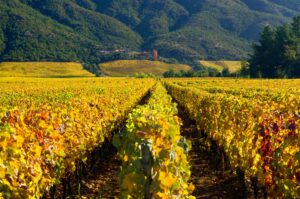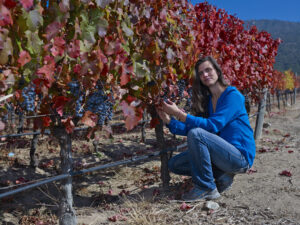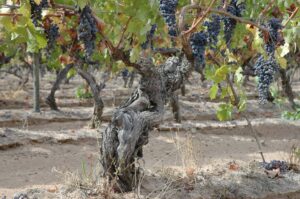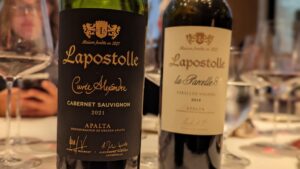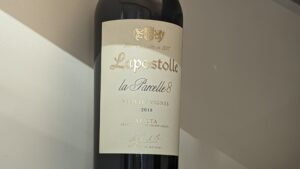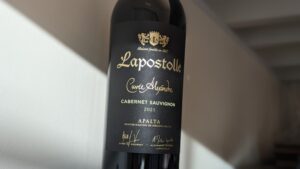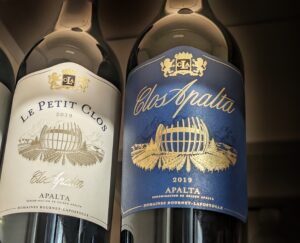For the first time in a long time, the locals felt excited as they were on the edge of a precipice that was at once terrifying yet thrilling. The isolation that was like an iron-clad cage around their desolate town would be destroyed, and they would be free to connect to a wider world while also losing the safety of only being among the close-knit community of multi-generational neighbors. These hardworking and newly hopeful people lived in a sub-region called Apalta Valley within the region of Colchagua in central Chile. Apalta is shaped like a horseshoe with mountains and rivers surrounding it, moderating temperatures. In the local dialect, apalta means “bad soil,” – referring to the low fertility of the land, so, very little in the way of crops could grow, except wine grape vines. It wasn’t ideal as their yields would be low, but at least they could sell grapes to make wine that would be exported to Argentina, and a whole new opportunity would open up for the next generation, as they would have enough money to send their kids to school.
It was the turn of the 20th century in the country of Chile, where the Pactos de Mayo agreement, combined with the opening of the Transandine Railway, would deter a war between Chile and Argentina as well as normalizing business relations that would include a free trade agreement between the two countries. But that would never come to pass, as the winegrowers in Argentina, many immigrants from Europe, fiercely fought the agreement, and in the end, it never came to fruition. Most of the 20th century in Chile involved instability within their government with excessive taxes and a tremendous amount of regulation that created insurmountable barriers, ultimately preventing the wine industry in Chile from taking off. And so, those low-yielding Cabernet Sauvignon vines planted in poor soil – encouraging low yields of concentrated grapes within an area with a wonderful balance between enough sunlight and moderated temperatures, sat safely in obscurity until a well-known French family discovered them.
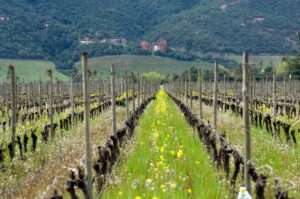
Photo Credit: WWW.MATTWILSON.CL
In 1994, Alexandra Marnier Lapostolle, part of the famous spirits and wine Marnier Lapostolle family, and her husband Cyril de Bournet, wanted to push the envelope by looking for vineyards with a great sense of place, aka terroir; when they found themselves in the Apalta Valley looking at Cabernet Sauvignon grapes planted in 1909 that has survived a semi-dry Mediterranean climate without any irrigation, they realized that they discovered their great terroir.
It was such an incredible shock to see such old Cabernet Sauvignon vines, as in the wine region of Bordeaux in France, they are typically replanted once a vine is around 35 years old, and over 50 is considered old vines. It is ironic to think that a well-known French spirits and wine family would find some of the oldest Cabernet Sauvignon vines in Chile, especially considering back in the 1990s when it was not considered a premium winemaking country.
Old Vines Cabernet Sauvignon
But Chile’s wine image would drastically improve with the help of Alexandra Marnier Lapostolle and Cyril de Bournet, one of the producers making Apalta an unofficial grand cru area with their iconic Clos Apalta wine and the premium lineup of their Lapostolle Wines.
Alexandra came from a family unafraid to push the boundaries as they created Grand Marnier, a blend of fine cognac and a bitter orange-flavored liqueur, that was initially controversial among other fine cognac producers, yet, it became a success and took the world by storm. And so, when she knew that there was an extraordinary sense of place, aka terroir, that existed in parts of Chile, she was not afraid of the blowback from those in the French fine wine world, as her family never allowed popular opinion to dissuade a passion project.
The next piece of the puzzle was finding the ideal person to oversee their treasured vineyards as well as make excellent wines. That is where head winemaker and viticulturist Andrea León completes the puzzle with her extensive winemaking experiences in France, Italy, the US and New Zealand. However, her homeland, Chile, ultimately called her back. Andrea has always had a deep love for the land, and that, combined with being raised in an artistic family, naturally led her to create something very artistically beautiful from nature – wine.
And she is undoubtedly thankful to work with such excellent vineyards, especially such rare old Cabernet Sauvignon. Still, she would never call their old vines the oldest of that grape variety, as there are possibly other plots around the world that might be older. One such, is located in Barossa Valley, Australia: Penfolds Cabernet Sauvignon Kalimna Block 42, which comes from vines believed to be around 130 years old. Another reason is that they employ the practice called marcottage in France, yet known as layering in other parts of the world. Marcottage is a very time-consuming practice where a cane coming from a grapevine is buried into the ground, where it will sprout roots and grow another plant. This way, it helps to keep these extremely old plants going, as they lose about 3% of these old vines every year. And so, each plant is an extension of one that was planted in 1909, and so, to some, that may count as a vineyard over a century old, and to others, it may not officially qualify. But no matter the technical requirements, whether it is expressed in the wine is all that matters.
la Parcelle 8
This unique section of old Cabernet Sauvignon vines typically go into the icon Clos Apalta bottling, but for vintages considered outstanding for this precious plot, a separate bottling within the Lapostolle line, under the name ‘la Parcelle 8,’ is released. Currently, only the second bottling to be released into the US, the 2018 vintage, has finally hit the market. Andrea noted that 2018 is one of the “greatest cold vintages” of this century as the ideal conditions allowed grapes to stay on the vine longer, allowing for fully mature fruit and complex flavors to develop while retaining acidity.
As one thinks back to the Apalta area over a century ago, when those Cabernet Sauvignon vines were first planted because no other crop would grow on such poor soil – not knowing that it was ideal for high-quality wine, the idea of what seems like a curse ended up becoming a blessing comes to mind. Not only was the poor soil, when food was needed more than anything else, a huge detriment, but once Chile became isolated from the rest of the world, there was no hope for a booming industry to improve the lives of the farmers, and so, even though it is a jaw-droppingly gorgeous place, it was hard for the locals to appreciate when they were barely surviving. But since Chile didn’t have a booming wine industry for so long, those vines were never uprooted for younger, higher yielding vines, and hence, when a member of a legendary French family was seeking out the potential of Chile vineyards and came upon the great treasure of the ‘la Parcelle 8’ block, they did not hesitate to make a tremendous investment in Chilean wine.
And today, that golden-hued, saffron-colored horizon created by the sunset that seems to kiss the mountains in Apalta, is almost the same as that which desperate farmers gazed upon over one hundred years ago. But in those days, it represented the end of another hopeless day filled with backbreaking labor that amounted to very little. Yet, today, it is a breathtaking display of the area’s magnificence that fine wine connoisseurs worldwide appreciate.
***Link to original Forbes article: https://www.forbes.com/sites/cathrinetodd/2023/11/09/some-of-the-oldest-cabernet-sauvignon-vines-in-the-wine-world-are-being-released-in-a-single-vineyard-bottling/
‘la Parcelle’ 8 & ultra-premium ‘Cuvée Alexandre’ wines:
2018 Lapostolle ‘la Parcelle 8’ Apalta, Colchagua Valley, Chile: 100% Cabernet Sauvignon. A wine that balances power and finesse beautifully with the deeply concentrated black fruit that is highlighted by a mixture of savory, tapenade, with enchanting notes, violets, that is at once decadently delicious with flavors of cocoa powder, and aristocratically pleasing with aromas of cigar box, all laced with an intense minerality and finely etched tannins.
2022 Lapostolle ‘Cuvée Alexandre’ Cabernet Franc, Apalta, Colchagua Valley, Chile: This Cabernet Franc ‘Cuvée Alexandre’ bottling is a new release for Lapostolle and it should hit the market in December of this year. Andrea León said that they have been very happy with how well their Cabernet Franc has been showing throughout the years, and that it finally deserved its own bottling; such an elegant wine with pretty aromas of jasmine with hints of blackcurrant leaf that has a fine structure with juicy blueberry fruit on the palate.
2021 Lapostolle ‘Cuvée Alexandre’ Cabernet Sauvignon, Apalta, Colchagua Valley, Chile: 85% Cabernet Sauvignon, 7% Cabernet Franc, 4% Merlot and 4% Petit Verdot. Multilayered dark fruit with cardamom and anise seed spices giving an aromatic lift to the fruit that has fresh sage herbs intermixed along the silky tannins that give enough structure for an overall elegant quality.
2021 Lapostolle ‘Cuvée Alexandre’ Carménère, Apalta, Colchagua Valley, Chile: 85% Carmenère, 6% Cabernet Franc, 5% Syrah and 4% Grenache. Ripe, juicy plum fruit from the first sip with complex notes of green peppercorn and crush granite with nicely manicured tannins that caress the palate.
Iconic ‘Clos Apalta’ and its second wine ‘Le Petit Clos’:
2019 Clos Apalta, Apalta, Colchagua Valley, Chile: 70% Carmenere, 18% Merlot, 8% Cabernet Sauvignon and 4% Petit Verdot. An exquisitely expressive nose with rich blackberry fruit interlaced with delectable notes of blueberry scone that has a creamy texture balance by bright acidity with notes of smoldering earth and sweet tobacco that has a long and flavorful finish.
2019 Clos Apalta, Le Petit Clos, Apalta, Colchagua Valley, Chile: 49% Carmenere, 30% Merlot, 18% Cabernet Sauvignon and 3% Petit Verdot. The second wine for Clos Apalta. A much more savory nose with singed herbs and sautéed cumin seeds with a round, inviting texture on the palate that has velvety tannins and a long, aromatic finish that is very spicy.
Moderately-priced Lapostolle wines:
2022 Lapostolle ‘Grand Selection’ Sauvignon Blanc, Rapel Valley, Central Valley, Chile: 100% Sauvignon Blanc. The citrus blossom and white nectarine aromas make this wine tasty from the first whiff that just gets tastier on the palate with juicy peach flavors.
2022 Lapostolle, le Rosé, Apalta, Colchagua Valley, Chile: 44% Cinsault, 38% Grenache, 12% Syrah and 6% Mourvèdre. Delicately pale color with hints of wildflowers and red strawberries with a dry, fresh finish that leaves notes of crushed rose petals and wet stones in one’s head.
2021 Lapostolle, Apalta Red, Colchagua Valley, Chile: 54% Cabernet Sauvignon, 23% Merlot, 10% Carmenère, 7% Cabernet Franc and 6% Syrah. Pristine red and black fruit with baking spices and a touch of dried herbs that is round and juicy on the palate.

